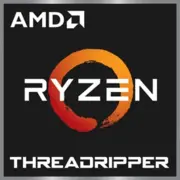AMD Ryzen Threadripper PRO 5955WX

AMD Ryzen Threadripper PRO 5955WX: Power for Professionals
Updated: March 2025
Introduction
AMD Ryzen Threadripper PRO processors have long established themselves as the benchmark for workstation performance. The Ryzen Threadripper PRO 5955WX, released in 2022, remains a relevant choice for professionals despite the emergence of new generations. In this article, we will discuss who this CPU is suitable for, how to use it properly, and what to consider when building a system.
Key Specifications
Architecture and Process Technology
The Threadripper PRO 5955WX is built on the Zen 3 architecture (codename Chagall) and is manufactured using TSMC's 7nm FinFET process technology. This ensures high energy efficiency for a processor with a TDP of 280W.
Key parameters:
- 16 cores / 32 threads — an optimal balance for multithreaded tasks.
- 64MB L3 cache — speeds up processing large datasets.
- PCIe 4.0 support — 128 lanes for connecting storage and graphics cards.
Performance:
- Geekbench 6: 2117 (single-core) / 15960 (multi-core).
- In rendering tests (Blender, V-Ray), the CPU outperforms the Intel Core i9-14900K by 30-40% due to its higher core count.
Features:
- PRO features: ECC memory support, remote management (DASH), hardware data protection.
- "Creator Mode" — automatic optimization for rendering and 3D modeling tasks.
Compatible Motherboards
The Threadripper PRO 5955WX uses the sWRX8 socket, which is only compatible with the WRX80 chipset.
Recommended models (2025):
- ASUS Pro WS WRX80E-SAGE SE ($600–700) — 8 PCIe 4.0 slots, 8 SATA ports.
- GIGABYTE WRX80 SU8 ($550–650) — reinforced VRM power system, supports 4 graphics cards.
Selection features:
- Form Factor: Most boards are E-ATX and require large cases.
- Cooling: VRM heatsinks should be passive or active (with fans) to handle sustained loads.
Supported Memory
The processor works only with DDR4 (DDR5 is not supported).
Recommendations:
- Type: DDR4-3200 with or without ECC (ECC is preferable for stability in work tasks).
- Configuration: Quad-channel mode (4 or 8 modules).
- Capacity: Minimum 64GB (4x16GB) for rendering, 128GB for virtualization.
Example: A Kingston Fury DDR4-3200 128GB kit (4x32GB) would cost about $450–500.
Power Supplies: Calculation and Recommendations
CPU TDP is 280W, but peak consumption can reach 320W.
Calculation formula:
- CPU: 320W.
- Graphics Card (e.g., NVIDIA RTX 4090): 450W.
- Other components: 100W.
Total: 870W → choose a PSU of at least 1000W.
Recommended models:
- Corsair HX1000i ($250) — 80 Plus Platinum, modular design.
- Seasonic PRIME TX-1000 ($270) — 12-year warranty, quiet operation.
Advice: Don't skimp on the PSU — overheating or unstable voltage can damage expensive components.
Pros and Cons of the Processor
Advantages:
1. Multithreaded performance: rendering, code compilation, simulations.
2. Reliability: ECC memory, overheating protection.
3. Scalability: support for 4 GPUs for machine learning.
Disadvantages:
1. Price: $1100–1300 (new, 2025) — more expensive than many desktop CPUs.
2. No DDR5 support: Competitors on Intel Sapphire Rapids have already moved to DDR5.
3. Overkill for gaming: lower frequency (up to 4.5GHz) compared to the Ryzen 7 7800X3D.
Use Cases
1. Work Tasks
- 3D Rendering: In Blender, the processor processes a scene in 6–8 minutes (compared to 12–15 minutes for Core i9-14900K).
- Virtualization: 32 threads allow running 10–12 virtual machines simultaneously.
- Video Encoding: Rendering an 8K video in Premiere Pro is reduced by 25% compared to Ryzen 9 7950X.
2. Gaming
Not the best choice: at Full HD, the difference with Ryzen 7 7800X3D can reach 40-50 FPS. However, at 4K with an RTX 4090, the processor delivers 90-120 FPS in most AAA games (e.g., Cyberpunk 2077).
3. Multimedia and Streaming
Suitable for streamers combining gaming and encoding: 32 threads easily handle OBS + game + browser.
Comparison with Competitors
1. Intel Xeon W7-2495X (Sapphire Rapids)
- Price: $1800.
- Pros: DDR5, AVX-512.
- Cons: 16 cores, but lower performance in multithreading (Geekbench 6 Multi: ~14500).
2. AMD Ryzen Threadripper 7960X (Zen 4)
- Price: $1600.
- Pros: 24 cores, DDR5.
- Cons: more expensive, overkill for tasks where 16 cores suffice.
Conclusion: The 5955WX wins on the price/performance ratio in the under $1500 segment.
Assembly Tips
1. Cooling:
- Cooler: Noctua NH-U14S TR5-SP3 ($90) or ASUS RYUJIN II 360 AIO ($250).
- Case: Lian Li PC-O11 Dynamic XL — space for a 360mm radiator and fans.
2. Storage: Use PCIe 4.0 NVMe (e.g., Samsung 990 Pro 2TB — $180) for faster project loading.
3. Graphics Card: For work tasks, RTX 4080 ($1100) is sufficient; for gaming, RTX 4090 ($2000).
4. Compatibility Check: Ensure the cooler supports sWRX8 and the case is compatible with E-ATX boards.
Final Conclusion: Who Should Choose the Threadripper PRO 5955WX
This processor is the right choice if you:
- Are a professional in 3D, CAD, or video: need stable multithreaded performance.
- Are an engineer or scientist: using simulations or neural networks.
- Are an IT specialist: deploying servers or virtual environments.
Why not for gamers? For the same $1300, you could build a PC with Ryzen 7 + RTX 4090 that gives twice the FPS.
The Threadripper PRO 5955WX is a tool for those who earn with performance. If you monetize every minute of rendering, this CPU will pay for itself in a year.
Basic
CPU Specifications
Memory Specifications
GPU Specifications
Miscellaneous
Benchmarks
Compared to Other CPU
Share in social media
Or Link To Us
<a href="https://cputronic.com/en/cpu/amd-ryzen-threadripper-pro-5955wx" target="_blank">AMD Ryzen Threadripper PRO 5955WX</a>